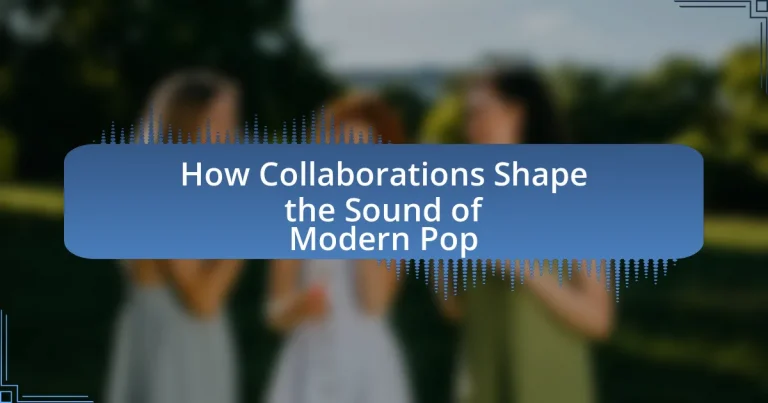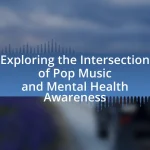Collaborations play a pivotal role in shaping the sound of modern pop music by merging diverse musical styles and cultural influences, resulting in innovative tracks that appeal to wider audiences. Key elements of these collaborations include songwriting, production, and performance, which enhance creativity and broaden artistic perspectives. Artists select collaborators based on shared visions and complementary skills, while producers and songwriters significantly influence the final sound. The article explores the increasing prevalence of collaborations, their impact on audience reach and marketing, notable examples, and the challenges artists face, ultimately highlighting how these partnerships drive the evolution of contemporary pop music.
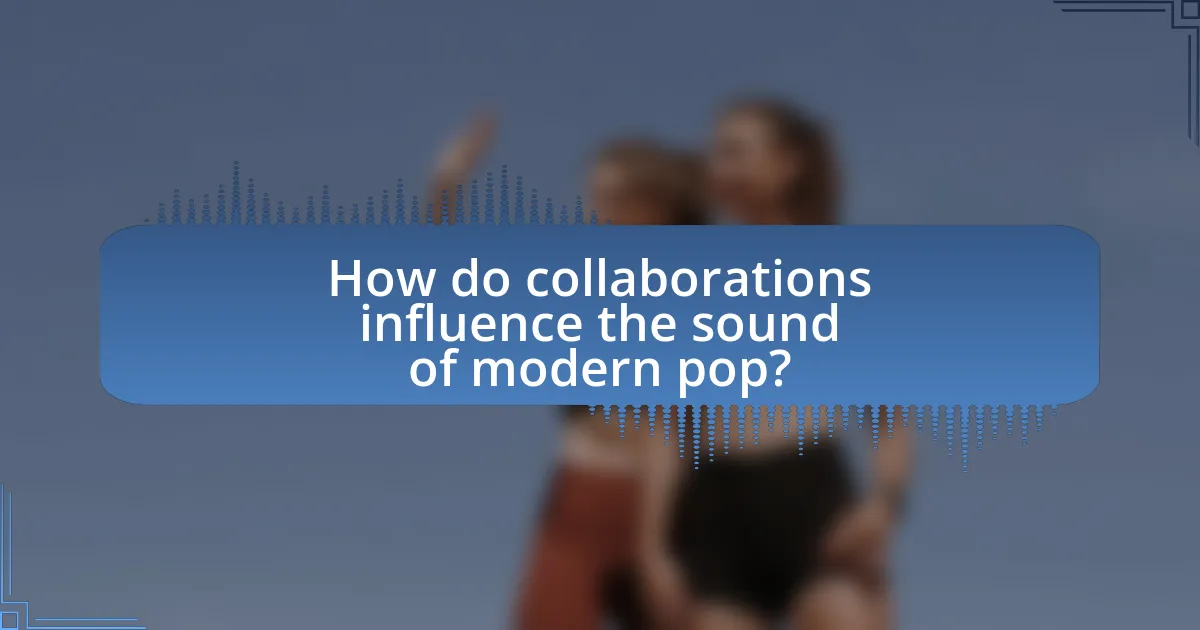
How do collaborations influence the sound of modern pop?
Collaborations significantly influence the sound of modern pop by blending diverse musical styles and cultural influences. This fusion often results in innovative sounds that appeal to a broader audience, as seen in tracks like “Despacito,” which combined reggaeton and pop elements, leading to its global success. Additionally, collaborations allow artists to leverage each other’s fan bases, enhancing exposure and driving commercial success. For instance, the partnership between Dua Lipa and Elton John on “Cold Heart” showcases how merging different genres can create a fresh sound that resonates with listeners. This trend is supported by data indicating that collaborative tracks frequently achieve higher chart positions compared to solo efforts, highlighting the effectiveness of this approach in shaping contemporary pop music.
What are the key elements of collaboration in pop music?
The key elements of collaboration in pop music include songwriting, production, and performance. Songwriting involves multiple artists contributing lyrics and melodies, which enhances creativity and diversity in the music. Production is crucial as it combines different styles and techniques from various producers, resulting in a unique sound. Performance collaboration often features artists sharing the stage, which can amplify audience engagement and broaden fan bases. For instance, the collaboration between Dua Lipa and Elton John on “Cold Heart” showcases how blending different musical backgrounds can create a chart-topping hit, demonstrating the effectiveness of these collaborative elements in shaping modern pop music.
How do artists choose their collaborators?
Artists choose their collaborators based on shared artistic vision, complementary skills, and mutual respect. They often seek individuals who enhance their creative process, bringing unique perspectives or expertise that align with their musical goals. For instance, many pop artists collaborate with producers who have a proven track record in the genre, as this can significantly influence the sound and commercial success of their work. Research indicates that successful collaborations often stem from prior relationships or recommendations within the industry, highlighting the importance of networking and trust in the selection process.
What roles do producers and songwriters play in collaborations?
Producers and songwriters play crucial roles in collaborations by shaping the overall sound and structure of a song. Producers are responsible for the technical aspects, including arranging, recording, and mixing, which directly influence the final sound quality and style. They often guide the creative process, making decisions about instrumentation and production techniques that align with the artistic vision. Songwriters, on the other hand, focus on crafting the lyrics and melodies, ensuring that the song conveys the intended message and emotional impact. Their collaboration leads to a cohesive piece that combines lyrical depth with polished production. This synergy is evident in successful pop collaborations, where the blend of innovative production and compelling songwriting results in chart-topping hits.
Why are collaborations becoming more common in the pop genre?
Collaborations are becoming more common in the pop genre due to the increasing demand for diverse sounds and the blending of fan bases. This trend allows artists to reach wider audiences and create innovative music by combining different styles and influences. For instance, the collaboration between Dua Lipa and Elton John on “Cold Heart” showcases how merging distinct musical backgrounds can lead to chart-topping hits. Additionally, data from the Recording Industry Association of America indicates that songs featuring multiple artists often perform better commercially, reinforcing the trend of collaboration in pop music.
How do collaborations enhance creativity and innovation?
Collaborations enhance creativity and innovation by combining diverse perspectives and skill sets, leading to unique ideas and solutions. When artists from different backgrounds work together, they bring varied experiences and techniques, which can inspire new approaches to music creation. For instance, the collaboration between pop artists and producers from different genres often results in innovative sounds that push the boundaries of traditional pop music. Research indicates that teams with diverse members are more likely to generate creative outcomes, as they can challenge each other’s assumptions and stimulate fresh thinking. This dynamic is evident in successful collaborations like those between Taylor Swift and Bon Iver, which resulted in a blend of pop and indie sounds, showcasing how collaboration can lead to groundbreaking musical innovation.
What impact do collaborations have on audience reach and marketing?
Collaborations significantly enhance audience reach and marketing effectiveness by combining the fan bases of the involved artists. This synergy allows for cross-promotion, where each artist introduces their audience to the other’s work, leading to increased visibility and engagement. For instance, a study by Nielsen Music found that collaborations can lead to a 30% increase in streaming numbers for the participating artists, as fans are more likely to explore new music from artists they already follow. Additionally, collaborations often generate buzz and media coverage, further amplifying marketing efforts and attracting new listeners.
What are some notable examples of successful collaborations in modern pop?
Notable examples of successful collaborations in modern pop include “Shallow” by Lady Gaga and Bradley Cooper, which won an Academy Award and topped charts globally, and “Señorita” by Shawn Mendes and Camila Cabello, which reached number one on the Billboard Hot 100 and garnered over a billion views on YouTube. Additionally, “Despacito” by Luis Fonsi featuring Daddy Yankee became a cultural phenomenon, breaking streaming records and earning multiple Grammy nominations. These collaborations demonstrate the power of combining different artistic talents to create commercially successful and critically acclaimed music.
How did specific collaborations change the trajectory of artists’ careers?
Specific collaborations have significantly altered the trajectories of artists’ careers by expanding their audience reach and enhancing their creative output. For instance, when Rihanna collaborated with Eminem on “Love the Way You Lie,” it not only topped charts globally but also solidified Rihanna’s status as a versatile artist capable of crossing genres. This collaboration led to increased sales and streaming numbers, with the song achieving over 12 million copies sold in the U.S. alone, demonstrating how such partnerships can elevate an artist’s commercial success and visibility. Similarly, the collaboration between Dua Lipa and Elton John on “Cold Heart” introduced Dua Lipa to a broader demographic, resulting in her music being featured in various media and increasing her fan base. These examples illustrate that strategic collaborations can propel artists into new markets and enhance their artistic credibility.
What trends can be observed from these collaborations?
Collaborations in modern pop music reveal a trend towards genre-blending and cross-cultural influences. Artists frequently combine elements from various genres, such as hip-hop, electronic, and traditional pop, resulting in innovative sounds that appeal to diverse audiences. For instance, the collaboration between Dua Lipa and Elton John on “Cold Heart” merges pop with disco, showcasing how established artists can revitalize their sound through partnerships. Additionally, collaborations often leverage social media platforms for promotion, enhancing visibility and engagement, as seen with the viral success of tracks like “Savage Love” by Jawsh 685 and Jason Derulo, which gained traction through TikTok. This trend indicates a shift in how music is created and consumed, emphasizing collaboration as a key driver of modern pop’s evolution.
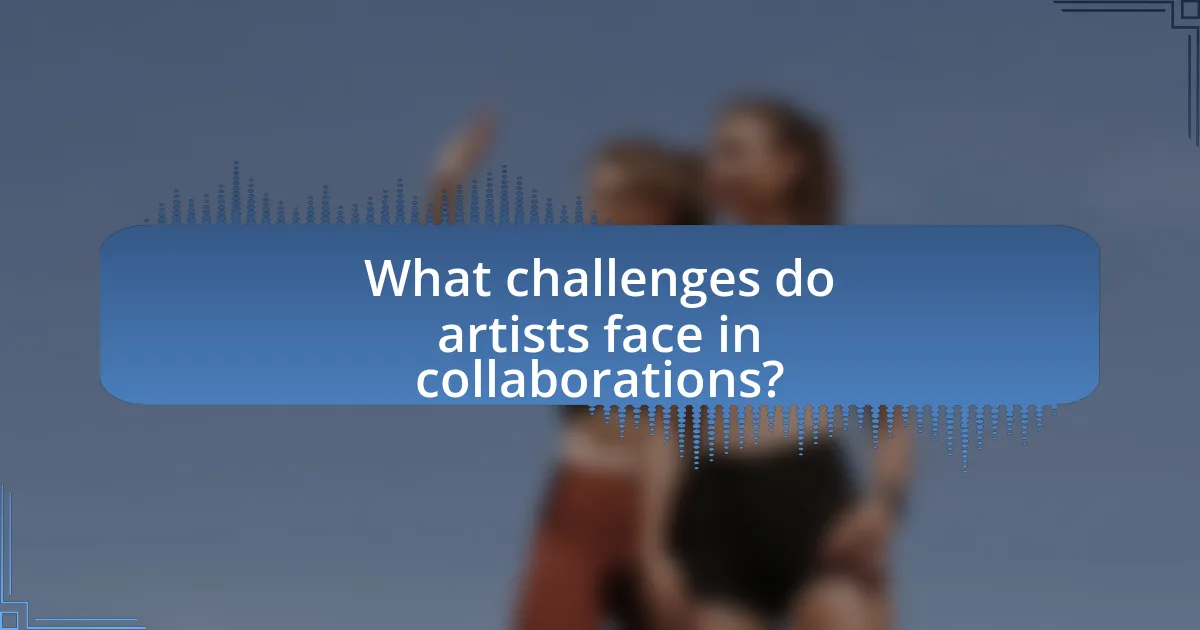
What challenges do artists face in collaborations?
Artists face several challenges in collaborations, including creative differences, communication issues, and logistical constraints. Creative differences often arise when artists have distinct visions or styles, leading to conflicts that can hinder the collaborative process. Communication issues can stem from misunderstandings or lack of clarity about roles and expectations, which can create friction among collaborators. Logistical constraints, such as scheduling conflicts and resource limitations, can also impede the collaboration, making it difficult for artists to align their efforts effectively. These challenges can ultimately affect the quality and cohesiveness of the final product in modern pop music collaborations.
How do creative differences affect collaborative projects?
Creative differences can significantly impact collaborative projects by leading to both innovation and conflict. When collaborators have varying artistic visions, these differences can spark unique ideas and enhance creativity, resulting in a richer final product. For instance, a study published in the Journal of Creative Behavior found that diverse perspectives often lead to more innovative solutions in team settings. However, if not managed effectively, these differences can also create tension, hinder communication, and delay project timelines. Research from the Harvard Business Review indicates that unresolved conflicts can lead to decreased team morale and productivity. Thus, while creative differences can drive collaboration forward, they require careful navigation to ensure positive outcomes.
What strategies can artists use to overcome conflicts?
Artists can use open communication, compromise, and collaboration to overcome conflicts. Open communication allows artists to express their concerns and perspectives clearly, fostering understanding and reducing misunderstandings. Compromise involves finding a middle ground where all parties can agree on certain aspects, which is crucial in collaborative environments. Collaboration itself encourages artists to work together towards a common goal, leveraging each other’s strengths to resolve disputes. Research indicates that effective communication and collaboration can significantly enhance creative outcomes, as seen in successful partnerships in the music industry, such as the collaboration between Dua Lipa and Elton John, which resulted in a harmonious blend of their distinct styles.
How do differing work styles impact the collaboration process?
Differing work styles significantly impact the collaboration process by influencing communication, decision-making, and overall productivity. For instance, individuals with a structured work style may prefer detailed plans and timelines, while those with a more flexible approach might thrive in spontaneous brainstorming sessions. This divergence can lead to misunderstandings or conflicts if not managed effectively. Research indicates that teams with diverse work styles can achieve higher creativity and innovation, as varied perspectives contribute to richer ideas. However, without clear communication and mutual respect for each style, collaboration can suffer, resulting in decreased efficiency and frustration among team members.
What are the risks associated with collaborations in pop music?
Collaborations in pop music carry several risks, including creative differences, brand dilution, and potential backlash from fans. Creative differences can lead to conflicts over artistic direction, which may result in a compromised final product or even the dissolution of the partnership. Brand dilution occurs when artists collaborate too frequently or with incompatible partners, potentially confusing their audience and weakening their individual brand identities. Additionally, collaborations can provoke backlash if fans perceive the partnership as inauthentic or opportunistic, which can harm the artists’ reputations and commercial success. For instance, when artists like Justin Bieber and Ed Sheeran collaborated, while it was commercially successful, it also faced scrutiny from purists who felt it strayed from their original styles.
How can collaborations dilute an artist’s brand or sound?
Collaborations can dilute an artist’s brand or sound by introducing conflicting musical styles or themes that do not align with the artist’s established identity. When artists collaborate with others who have significantly different genres or artistic visions, the resulting work may confuse listeners and weaken the artist’s brand coherence. For example, when a pop artist known for upbeat, catchy songs collaborates with a heavy metal musician, the final product may alienate existing fans and fail to attract new ones, leading to a dilution of the artist’s core sound. This phenomenon is supported by the observation that artists who frequently shift their musical direction through collaborations often experience a decline in brand loyalty, as seen in cases like the mixed reception of certain high-profile collaborations in the music industry.
What legal issues might arise during collaborations?
Legal issues that might arise during collaborations include copyright infringement, contract disputes, and intellectual property rights. Copyright infringement can occur if collaborators use each other’s work without permission, leading to potential legal action. Contract disputes may arise from disagreements over terms, responsibilities, or profit-sharing, which can complicate the collaboration process. Additionally, intellectual property rights issues can surface when determining ownership of created content, especially in cases where multiple parties contribute to a project. These legal challenges can significantly impact the success and dynamics of collaborative efforts in the music industry.
How do collaborations affect the songwriting and production process?
Collaborations significantly enhance the songwriting and production process by integrating diverse perspectives and skills. When artists collaborate, they combine their unique influences, leading to innovative melodies and lyrics that may not emerge in solo efforts. For instance, a study by the Berklee College of Music found that songs created through collaboration often exhibit greater commercial success, as they leverage the strengths of multiple creators, resulting in a richer sound and broader appeal. This collaborative dynamic fosters creativity, allowing for experimentation with different genres and production techniques, ultimately shaping the sound of modern pop music.
What are the benefits of co-writing songs with other artists?
Co-writing songs with other artists enhances creativity and broadens musical perspectives. Collaborating allows artists to combine their unique styles and ideas, resulting in innovative compositions that may not emerge in solo writing. For instance, a study by the University of Southern California found that collaborative songwriting often leads to higher-quality music, as diverse influences contribute to richer lyrical and melodic content. Additionally, co-writing can expand an artist’s network, providing opportunities for exposure and collaboration with other musicians, which is crucial in the competitive landscape of modern pop music.
How does collaboration influence the production techniques used in pop music?
Collaboration significantly influences the production techniques used in pop music by integrating diverse creative inputs and expertise from multiple artists and producers. This collaborative approach often leads to innovative soundscapes, as different musical styles and production methods are blended together. For instance, the partnership between artists and producers like Max Martin and Taylor Swift has resulted in the use of advanced digital production techniques, such as layering and sampling, which enhance the overall sound quality and appeal of pop tracks. Additionally, collaborations often involve cross-genre experimentation, allowing for the incorporation of elements from hip-hop, electronic, and rock, which further diversifies the production techniques employed in pop music.
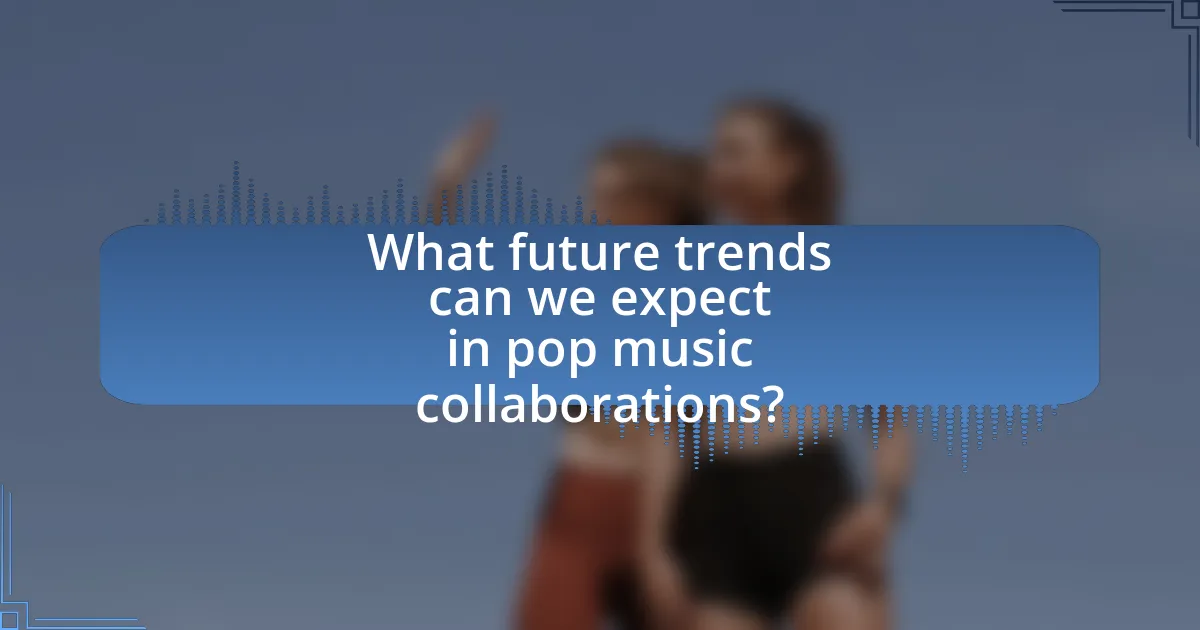
What future trends can we expect in pop music collaborations?
Future trends in pop music collaborations will increasingly focus on genre-blending and global influences. As artists seek to reach wider audiences, collaborations will likely incorporate diverse musical styles, such as fusing pop with hip-hop, electronic, and traditional music from various cultures. This trend is supported by the success of recent cross-genre collaborations, such as the blending of Latin rhythms in mainstream pop hits, which have significantly increased streaming numbers and chart performance. Additionally, advancements in technology will facilitate remote collaborations, allowing artists from different geographical locations to work together seamlessly, further enhancing the diversity and richness of pop music.
How is technology shaping collaborations in modern pop?
Technology is significantly shaping collaborations in modern pop by enabling artists to connect and create music across geographical boundaries. Digital platforms like SoundCloud, Spotify, and social media facilitate real-time collaboration, allowing musicians to share ideas, tracks, and feedback instantly. For instance, the rise of cloud-based software such as Splice allows producers and artists to collaborate on projects remotely, leading to innovative sounds and diverse influences in pop music. Additionally, data analytics tools help artists identify potential collaborators based on listener demographics and trends, further enhancing the collaborative process. This technological integration has resulted in a more interconnected music industry, where cross-genre collaborations are increasingly common, exemplified by partnerships like that of Billie Eilish and Khalid, which blend different musical styles and reach wider audiences.
What role do social media and streaming platforms play in facilitating collaborations?
Social media and streaming platforms play a crucial role in facilitating collaborations by providing artists with accessible tools for communication and exposure. These platforms enable musicians to connect with each other, share ideas, and collaborate on projects regardless of geographical barriers. For instance, platforms like Instagram and TikTok allow artists to showcase their work, leading to potential partnerships, while streaming services like Spotify offer collaborative playlists that can introduce artists to new audiences. The 2021 Spotify Wrapped report indicated that collaborative tracks gained significant traction, highlighting the effectiveness of these platforms in promoting joint efforts among artists.
How are virtual collaborations changing the landscape of pop music?
Virtual collaborations are transforming the landscape of pop music by enabling artists from diverse geographical locations to create music together in real-time, thus broadening the range of influences and styles incorporated into pop songs. This shift is evidenced by the rise of platforms like Splice and Soundtrap, which facilitate remote collaboration, allowing musicians to work together seamlessly regardless of their physical location. For instance, the song “Despacito” saw contributions from artists across different countries, showcasing how virtual collaboration can lead to global hits that blend various cultural elements. Additionally, data from the Recording Industry Association of America indicates that collaborations have increased in frequency, reflecting a trend where artists leverage technology to enhance creativity and reach wider audiences.
What emerging artists are leading the way in collaborative efforts?
Emerging artists leading the way in collaborative efforts include Olivia Rodrigo, who has collaborated with established artists like Taylor Swift and Jack Antonoff, and Swae Lee, known for his work with Post Malone and other artists. These collaborations have significantly influenced the sound of modern pop, blending genres and styles. For instance, Olivia Rodrigo’s partnership with Taylor Swift on “1 step forward, 3 steps back” showcases a fusion of pop and indie elements, while Swae Lee’s contributions to tracks like “Sunflower” highlight the integration of hip-hop and pop. Such collaborations not only enhance the artists’ visibility but also shape contemporary music trends.
How do these artists leverage collaborations to build their careers?
Artists leverage collaborations to build their careers by expanding their audience reach and enhancing their creative output. Collaborations allow artists to tap into each other’s fan bases, which can significantly increase visibility and attract new listeners. For instance, when a well-established artist collaborates with an emerging talent, the latter gains exposure to a broader audience, as seen in the partnership between Dua Lipa and Elton John, which introduced her to his extensive fan base. Additionally, collaborations often lead to innovative soundscapes, as artists blend their unique styles, resulting in fresh music that resonates with diverse audiences. This creative synergy can lead to chart-topping hits, further solidifying their positions in the industry.
What unique styles or genres are being created through these collaborations?
Collaborations in modern pop are creating unique styles such as genre-blending pop, which combines elements from hip-hop, electronic, and R&B. For instance, artists like Billie Eilish and Khalid have merged pop with electronic and R&B influences, resulting in a sound that is both innovative and commercially successful. Additionally, the collaboration between pop artists and producers from different genres, such as the partnership between Dua Lipa and Elton John, has led to the emergence of disco-infused pop, revitalizing classic sounds for contemporary audiences. These collaborations not only expand the sonic palette of pop music but also reflect the diverse musical influences that shape the genre today.
What best practices should artists follow when collaborating?
Artists should prioritize clear communication when collaborating to ensure that all parties understand their roles, expectations, and creative visions. Effective communication fosters a collaborative environment where ideas can be freely exchanged, leading to innovative outcomes. Additionally, establishing mutual respect and trust among collaborators is crucial, as it encourages open dialogue and constructive feedback. Research indicates that successful collaborations often stem from artists valuing each other’s contributions, which enhances creativity and productivity. Furthermore, setting defined goals and timelines helps keep the collaboration focused and organized, allowing artists to track progress and make necessary adjustments. By adhering to these best practices, artists can maximize the potential of their collaborations, ultimately shaping the sound of modern pop music.
How can artists ensure a successful collaborative experience?
Artists can ensure a successful collaborative experience by establishing clear communication and shared goals from the outset. Effective communication fosters understanding and alignment on creative visions, which is crucial in collaborative settings. Research indicates that projects with defined objectives and open dialogue among team members lead to higher satisfaction and better outcomes. For instance, a study published in the Journal of Creative Behavior found that teams with clear roles and responsibilities were 30% more likely to achieve their creative goals compared to those without such clarity. By prioritizing these elements, artists can enhance their collaborative efforts and produce more cohesive and innovative work.
What common pitfalls should artists avoid in collaborations?
Artists should avoid lack of clear communication in collaborations. Clear communication ensures that all parties understand their roles, expectations, and creative visions, which is crucial for a successful partnership. Misunderstandings can lead to conflicts, dissatisfaction, and ultimately, a failed project. Additionally, artists should avoid neglecting to establish boundaries regarding creative input and decision-making authority, as this can result in power struggles and resentment. Lastly, artists must refrain from overlooking the importance of mutual respect and compromise, as these elements are vital for fostering a collaborative environment that encourages creativity and innovation.
